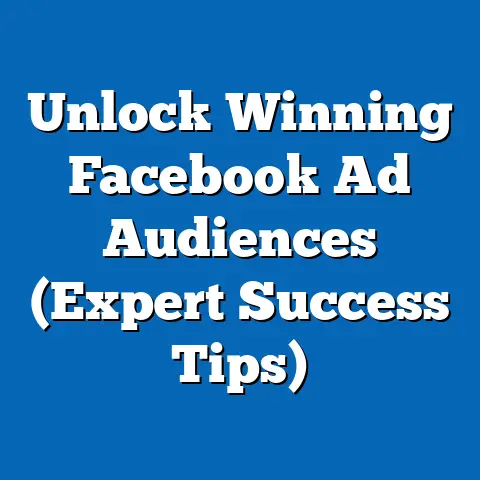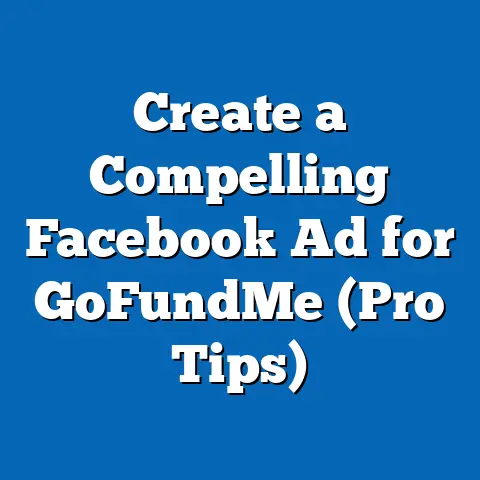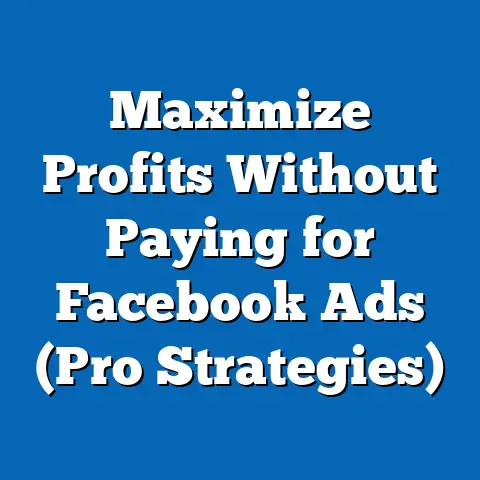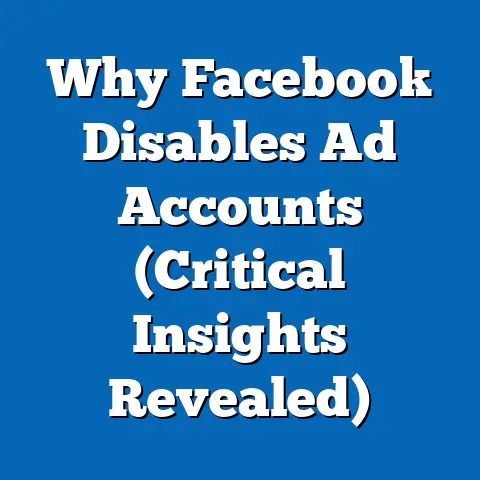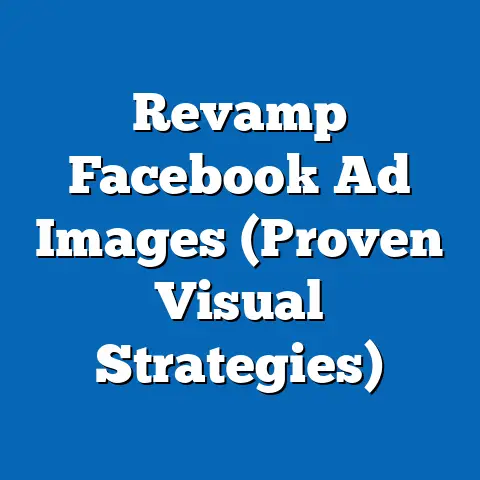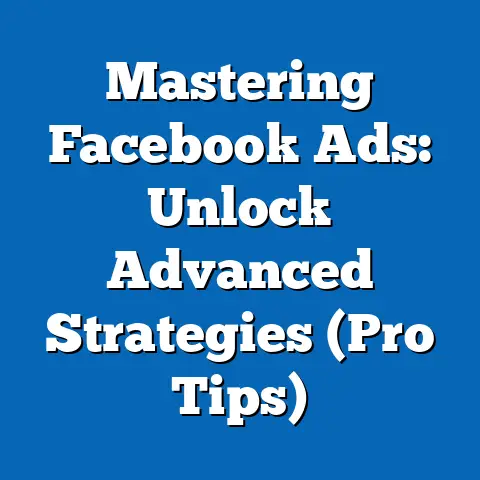Stop Unwanted Facebook Adds (Proven Engagement Strategies)
In a world where we’re constantly told that advertisements are becoming more and more personalized, why does it often feel like we’re being bombarded by more unwanted Facebook ads than ever before? It’s a paradox, isn’t it? We have algorithms that can predict our next purchase, data-driven marketing techniques that promise laser-sharp targeting, and yet… the ads that clutter our feeds often feel irrelevant, intrusive, and downright annoying. I’ve seen this firsthand, both as a marketer and a user, and it’s a problem that needs addressing. It’s time we flipped the script and focused on creating ads that people actually want to see.
This isn’t just about being nice; it’s about being effective. An unwanted ad isn’t just a nuisance; it’s a wasted marketing opportunity. It damages brand perception, erodes trust, and ultimately, hurts your bottom line. In this guide, I’ll break down the reasons why unwanted ads are so prevalent on Facebook, and more importantly, I’ll share proven engagement strategies that can help you create more relevant, engaging, and ultimately, welcomed ads.
Understanding the User Experience
Let’s be honest, how many times have you scrolled through your Facebook feed, only to be interrupted by an ad that feels completely out of left field? You might be a passionate vegan cook, suddenly bombarded with ads for a steakhouse. Or perhaps you’re browsing for eco-friendly cleaning products and get an ad for fast fashion. It’s jarring, and it highlights a fundamental disconnect between the promise of targeted advertising and the reality of the user experience.
The Good, the Bad, and the Ugly of Facebook Ads:
- Effective Ads: These are the ads that seamlessly integrate into your feed. They’re relevant to your interests, offer genuine value, and don’t feel overly pushy. They might introduce you to a new product you’re genuinely interested in, remind you of a service you need, or offer a helpful discount.
- Ineffective Ads: These are the ads that miss the mark. They’re poorly targeted, irrelevant to your interests, and often feel like an interruption to your browsing experience. They might promote products you’d never buy or services you’d never use.
- Unwanted Ads: These are the ads that are not only ineffective but actively annoying. They might be repetitive, intrusive, or promote products or services that are offensive or irrelevant to your values.
Ad Fatigue: The Enemy of Engagement:
One of the biggest contributors to negative feelings toward Facebook ads is ad fatigue. This happens when users are repeatedly exposed to the same ad, or similar ads from the same brand, to the point where they become numb to the message. It’s like hearing the same song on repeat – eventually, you’ll start to tune it out, or worse, actively dislike it.
The Numbers Don’t Lie:
Studies consistently show that users are growing increasingly frustrated with irrelevant and intrusive ads. A recent survey by HubSpot found that 68% of consumers said they were less likely to trust a brand if they saw an ad that was poorly targeted. That’s a significant number, and it underscores the importance of prioritizing relevance and engagement in your Facebook advertising strategy.
Takeaway: Understanding the user experience is the first step to creating better ads. Recognize the difference between effective and ineffective ads, be mindful of ad fatigue, and remember that relevance is key to capturing attention and building trust.
The Psychology Behind Engagement
Why do some ads grab our attention while others are instantly dismissed? The answer lies in the psychology of engagement. Understanding how our brains process information, what captures our attention, and what motivates us to act is crucial for creating ads that resonate with your target audience.
Attention and Distraction: The Battle for Eyeballs:
In today’s digital landscape, we’re constantly bombarded with information. Our attention spans are shorter than ever, and we’re constantly filtering out stimuli that we deem irrelevant or uninteresting. Unwanted ads are a prime example of this. They disrupt our browsing experience, demand our attention without offering anything in return, and are quickly dismissed as noise.
Relevance and Resonance: Speaking to the User’s Needs:
The key to overcoming this challenge is to create ads that are both relevant and resonant.
- Relevance means that your ads are targeted to users who are likely to be interested in your products or services. This requires a deep understanding of your target audience, their demographics, interests, and behaviors.
- Resonance means that your ads connect with users on an emotional level. They speak to their needs, desires, and aspirations. They tell a story, evoke a feeling, or offer a solution to a problem.
Case Study: Dove’s “Real Beauty” Campaign:
A prime example of a campaign that successfully utilized psychological principles to enhance user experience is Dove’s “Real Beauty” campaign. This campaign challenged traditional beauty standards and celebrated the diversity of women’s bodies. It resonated with women on an emotional level, sparking conversations about self-acceptance and body positivity. The campaign was incredibly successful, not only in terms of brand awareness but also in terms of building trust and loyalty among consumers.
The Psychology of Color and Visuals:
Don’t underestimate the power of visuals! The colors you use in your ads can evoke specific emotions and influence user behavior. For example, blue often conveys trust and stability, while red can create a sense of urgency. Similarly, the images you use can play a significant role in capturing attention and conveying your message. High-quality, visually appealing images that are relevant to your target audience can significantly increase engagement.
Takeaway: To create engaging ads, you need to understand the psychology behind attention, relevance, and resonance. Target your ads to the right audience, connect with them on an emotional level, and use visuals that capture their attention and convey your message effectively.
Proven Strategies to Reduce Unwanted Ads
Now that we understand the importance of relevance and engagement, let’s dive into some proven strategies that can help you reduce unwanted ads and create more effective campaigns.
-
Target Audience Segmentation:
- The Importance: Generic ads are a surefire way to annoy your audience. You need to understand who you’re talking to, their needs, their pain points, and their aspirations. That’s where audience segmentation comes in.
- How to Do It:
- Demographic Segmentation: Segment your audience based on age, gender, location, education, and income.
- Interest-Based Segmentation: Target users based on their interests, hobbies, and passions.
- Behavioral Segmentation: Target users based on their online behavior, such as their purchase history, website visits, and engagement with other ads.
- Custom Audiences: Upload your own customer data to create custom audiences. This allows you to target your existing customers with personalized ads.
- Lookalike Audiences: Create lookalike audiences based on your existing customers. This allows you to reach new users who share similar characteristics with your best customers.
- My Experience: I once worked with a clothing retailer that was struggling to generate sales through Facebook ads. After implementing a robust audience segmentation strategy, we saw a significant increase in conversion rates. By targeting different segments of their audience with personalized ads that spoke to their specific needs and interests, we were able to drive more sales and reduce the number of unwanted ads.
- Example: Instead of running a single ad promoting all of your products, create separate ads for different product categories and target them to users who have expressed an interest in those categories.
-
Personalization Techniques:
- The Power of “Me”: People respond to ads that feel personal and relevant to their individual needs. Personalization can be as simple as using the user’s name in the ad copy or as complex as tailoring the ad creative based on their past behavior.
- How to Do It:
- Dynamic Product Ads: Showcase products that users have previously viewed on your website.
- Personalized Ad Copy: Use data to tailor the ad copy to the user’s interests and needs.
- Location-Based Targeting: Target users based on their location and offer them deals and promotions that are relevant to their area.
- Retargeting: Show ads to users who have previously interacted with your website or social media pages.
- My Experience: I’ve seen firsthand how effective personalized ads can be. In one campaign, we used dynamic product ads to retarget users who had abandoned their shopping carts on an e-commerce website. By showing them the exact products they had left behind, we were able to recover a significant number of lost sales.
- Example: If you’re running a promotion for a specific product, target users who have previously purchased that product or similar products.
-
Dynamic Creative Optimization (DCO):
- The Algorithm’s Advantage: DCO leverages the power of algorithms to automatically test and optimize ad creatives based on performance. This means that you can test different headlines, images, and calls to action to find the combination that resonates best with your target audience.
- How to Do It:
- Upload Multiple Assets: Upload multiple versions of your ad creative, including different headlines, images, and calls to action.
- Let the Algorithm Work: Facebook’s algorithm will automatically test different combinations of these assets and show the most effective combinations to your target audience.
- Analyze the Results: Monitor the performance of your DCO campaigns and use the data to inform your future ad strategies.
- My Experience: I’ve found that DCO is particularly effective for campaigns with large budgets and broad target audiences. By allowing the algorithm to test different creative combinations, you can quickly identify the most engaging content and optimize your ad spend accordingly.
- Example: You could upload multiple headlines, images, and calls to action for a single ad and let Facebook’s algorithm determine which combination performs best.
-
User-Generated Content (UGC):
- Authenticity Wins: In a world of polished marketing messages, UGC stands out as authentic and trustworthy. By incorporating UGC into your ads, you can increase engagement and build trust with your target audience.
- How to Do It:
- Run a Contest: Encourage users to submit photos or videos of themselves using your products or services.
- Feature Customer Reviews: Highlight positive customer reviews in your ads.
- Partner with Influencers: Collaborate with influencers to create content that showcases your products or services.
- My Experience: I’ve seen brands successfully use UGC to create highly engaging ad campaigns. By featuring real customers using their products, they were able to build trust and credibility with their target audience.
- Example: A fitness brand could feature photos and videos of their customers working out and sharing their fitness journey.
-
A/B Testing:
- Continuous Improvement: A/B testing is the process of comparing two versions of an ad to see which one performs better. This allows you to continuously improve your ad creatives and optimize your campaigns for maximum engagement.
- How to Do It:
- Identify a Variable: Choose a single variable to test, such as the headline, image, or call to action.
- Create Two Versions: Create two versions of your ad, each with a different version of the variable you’re testing.
- Run the Test: Run the test for a sufficient period of time to gather statistically significant data.
- Analyze the Results: Analyze the results and determine which version of the ad performed better.
- Implement the Winning Version: Implement the winning version of the ad in your ongoing campaigns.
- My Experience: A/B testing is an essential part of any successful Facebook advertising strategy. By continuously testing and optimizing your ad creatives, you can significantly improve your campaign performance and reduce the number of unwanted ads.
- Example: You could test two different headlines for an ad to see which one generates more clicks.
Target Audience Segmentation:
- The Importance: Generic ads are a surefire way to annoy your audience. You need to understand who you’re talking to, their needs, their pain points, and their aspirations. That’s where audience segmentation comes in.
- How to Do It:
- Demographic Segmentation: Segment your audience based on age, gender, location, education, and income.
- Interest-Based Segmentation: Target users based on their interests, hobbies, and passions.
- Behavioral Segmentation: Target users based on their online behavior, such as their purchase history, website visits, and engagement with other ads.
- Custom Audiences: Upload your own customer data to create custom audiences. This allows you to target your existing customers with personalized ads.
- Lookalike Audiences: Create lookalike audiences based on your existing customers. This allows you to reach new users who share similar characteristics with your best customers.
- My Experience: I once worked with a clothing retailer that was struggling to generate sales through Facebook ads. After implementing a robust audience segmentation strategy, we saw a significant increase in conversion rates. By targeting different segments of their audience with personalized ads that spoke to their specific needs and interests, we were able to drive more sales and reduce the number of unwanted ads.
- Example: Instead of running a single ad promoting all of your products, create separate ads for different product categories and target them to users who have expressed an interest in those categories.
- Demographic Segmentation: Segment your audience based on age, gender, location, education, and income.
- Interest-Based Segmentation: Target users based on their interests, hobbies, and passions.
- Behavioral Segmentation: Target users based on their online behavior, such as their purchase history, website visits, and engagement with other ads.
- Custom Audiences: Upload your own customer data to create custom audiences. This allows you to target your existing customers with personalized ads.
- Lookalike Audiences: Create lookalike audiences based on your existing customers. This allows you to reach new users who share similar characteristics with your best customers.
Personalization Techniques:
- The Power of “Me”: People respond to ads that feel personal and relevant to their individual needs. Personalization can be as simple as using the user’s name in the ad copy or as complex as tailoring the ad creative based on their past behavior.
- How to Do It:
- Dynamic Product Ads: Showcase products that users have previously viewed on your website.
- Personalized Ad Copy: Use data to tailor the ad copy to the user’s interests and needs.
- Location-Based Targeting: Target users based on their location and offer them deals and promotions that are relevant to their area.
- Retargeting: Show ads to users who have previously interacted with your website or social media pages.
- My Experience: I’ve seen firsthand how effective personalized ads can be. In one campaign, we used dynamic product ads to retarget users who had abandoned their shopping carts on an e-commerce website. By showing them the exact products they had left behind, we were able to recover a significant number of lost sales.
- Example: If you’re running a promotion for a specific product, target users who have previously purchased that product or similar products.
- Dynamic Product Ads: Showcase products that users have previously viewed on your website.
- Personalized Ad Copy: Use data to tailor the ad copy to the user’s interests and needs.
- Location-Based Targeting: Target users based on their location and offer them deals and promotions that are relevant to their area.
- Retargeting: Show ads to users who have previously interacted with your website or social media pages.
Dynamic Creative Optimization (DCO):
- The Algorithm’s Advantage: DCO leverages the power of algorithms to automatically test and optimize ad creatives based on performance. This means that you can test different headlines, images, and calls to action to find the combination that resonates best with your target audience.
- How to Do It:
- Upload Multiple Assets: Upload multiple versions of your ad creative, including different headlines, images, and calls to action.
- Let the Algorithm Work: Facebook’s algorithm will automatically test different combinations of these assets and show the most effective combinations to your target audience.
- Analyze the Results: Monitor the performance of your DCO campaigns and use the data to inform your future ad strategies.
- My Experience: I’ve found that DCO is particularly effective for campaigns with large budgets and broad target audiences. By allowing the algorithm to test different creative combinations, you can quickly identify the most engaging content and optimize your ad spend accordingly.
- Example: You could upload multiple headlines, images, and calls to action for a single ad and let Facebook’s algorithm determine which combination performs best.
- Upload Multiple Assets: Upload multiple versions of your ad creative, including different headlines, images, and calls to action.
- Let the Algorithm Work: Facebook’s algorithm will automatically test different combinations of these assets and show the most effective combinations to your target audience.
- Analyze the Results: Monitor the performance of your DCO campaigns and use the data to inform your future ad strategies.
User-Generated Content (UGC):
- Authenticity Wins: In a world of polished marketing messages, UGC stands out as authentic and trustworthy. By incorporating UGC into your ads, you can increase engagement and build trust with your target audience.
- How to Do It:
- Run a Contest: Encourage users to submit photos or videos of themselves using your products or services.
- Feature Customer Reviews: Highlight positive customer reviews in your ads.
- Partner with Influencers: Collaborate with influencers to create content that showcases your products or services.
- My Experience: I’ve seen brands successfully use UGC to create highly engaging ad campaigns. By featuring real customers using their products, they were able to build trust and credibility with their target audience.
- Example: A fitness brand could feature photos and videos of their customers working out and sharing their fitness journey.
- Run a Contest: Encourage users to submit photos or videos of themselves using your products or services.
- Feature Customer Reviews: Highlight positive customer reviews in your ads.
- Partner with Influencers: Collaborate with influencers to create content that showcases your products or services.
A/B Testing:
- Continuous Improvement: A/B testing is the process of comparing two versions of an ad to see which one performs better. This allows you to continuously improve your ad creatives and optimize your campaigns for maximum engagement.
- How to Do It:
- Identify a Variable: Choose a single variable to test, such as the headline, image, or call to action.
- Create Two Versions: Create two versions of your ad, each with a different version of the variable you’re testing.
- Run the Test: Run the test for a sufficient period of time to gather statistically significant data.
- Analyze the Results: Analyze the results and determine which version of the ad performed better.
- Implement the Winning Version: Implement the winning version of the ad in your ongoing campaigns.
- My Experience: A/B testing is an essential part of any successful Facebook advertising strategy. By continuously testing and optimizing your ad creatives, you can significantly improve your campaign performance and reduce the number of unwanted ads.
- Example: You could test two different headlines for an ad to see which one generates more clicks.
- Identify a Variable: Choose a single variable to test, such as the headline, image, or call to action.
- Create Two Versions: Create two versions of your ad, each with a different version of the variable you’re testing.
- Run the Test: Run the test for a sufficient period of time to gather statistically significant data.
- Analyze the Results: Analyze the results and determine which version of the ad performed better.
- Implement the Winning Version: Implement the winning version of the ad in your ongoing campaigns.
Takeaway: By implementing these proven engagement strategies, you can create more relevant, engaging, and ultimately, welcomed ads. Remember to focus on understanding your audience, personalizing your ads, leveraging the power of algorithms, incorporating UGC, and continuously testing and optimizing your campaigns.
Measuring Success and Engagement
Creating engaging ads is only half the battle. You also need to measure your results to see what’s working and what’s not. This requires tracking key performance indicators (KPIs) that provide insights into the effectiveness of your campaigns.
Key Performance Indicators (KPIs):
- Click-Through Rate (CTR): This measures the percentage of users who click on your ad after seeing it. A higher CTR indicates that your ad is relevant and engaging to your target audience.
- Engagement Rate: This measures the percentage of users who interact with your ad, such as liking, commenting, or sharing it. A higher engagement rate indicates that your ad is resonating with your audience on an emotional level.
- Conversion Rate: This measures the percentage of users who take a desired action after clicking on your ad, such as making a purchase or filling out a form. A higher conversion rate indicates that your ad is effectively driving results.
- Relevance Score: This is a metric that Facebook uses to assess the relevance of your ad to your target audience. A higher relevance score indicates that your ad is likely to be shown to more users and at a lower cost.
- Frequency: This measures how often users are seeing your ads. Monitoring frequency is crucial for avoiding ad fatigue.
- Cost Per Click (CPC): This measures the cost you pay each time someone clicks on your ad.
- Cost Per Mille (CPM): This measures the cost you pay for every 1,000 impressions of your ad.
Using Metrics to Inform Future Ad Strategies:
By tracking these KPIs, you can gain valuable insights into the effectiveness of your ad campaigns. For example, if you see that your CTR is low, it might indicate that your ad copy or creative is not compelling enough. If your engagement rate is low, it might indicate that your ad is not resonating with your target audience. And if your conversion rate is low, it might indicate that your landing page is not optimized for conversions.
Reducing Unwanted Ads Over Time:
By using these insights to inform your future ad strategies, you can continuously improve your campaign performance and reduce the number of unwanted ads over time. This will not only improve your ROI but also enhance the user experience and build trust with your target audience.
Takeaway: Measuring success is essential for optimizing your Facebook advertising campaigns. Track key performance indicators, analyze the results, and use the data to inform your future ad strategies. By continuously improving your campaigns, you can reduce the number of unwanted ads and create more effective and engaging experiences for your target audience.
The Future of Facebook Advertising
The world of Facebook advertising is constantly evolving, with new technologies and trends emerging all the time. Understanding these trends and preparing for the future is crucial for staying ahead of the curve and creating effective campaigns that resonate with your target audience.
Emerging Technologies: AI and Machine Learning:
One of the biggest trends in Facebook advertising is the increasing use of AI and machine learning. These technologies are being used to automate various aspects of the advertising process, from audience targeting to creative optimization. For example, AI-powered tools can now analyze vast amounts of data to identify the most promising target audiences and automatically generate ad creatives that are tailored to their specific needs and interests.
The Potential Impact on Ad Personalization and Targeting:
The increasing use of AI and machine learning has the potential to significantly improve ad personalization and targeting. By leveraging these technologies, businesses can create more relevant and engaging ads that are tailored to the individual needs and preferences of their target audience. This will not only improve campaign performance but also reduce the number of unwanted ads and enhance the user experience.
Preparing for the Future:
To prepare for the future of Facebook advertising, businesses need to invest in the skills and technologies that will enable them to leverage the power of AI and machine learning. This includes hiring data scientists and machine learning engineers, as well as investing in AI-powered advertising tools. Businesses also need to be prepared to adapt their strategies as the technology continues to evolve.
The Metaverse and Beyond:
While still in its early stages, the metaverse presents a new frontier for advertising. Imagine immersive ad experiences that blend the physical and digital worlds. Facebook (Meta) is investing heavily in this space, and it’s likely to have a significant impact on the future of advertising.
Takeaway: The future of Facebook advertising is bright, with new technologies and trends emerging all the time. By staying informed and adapting their strategies accordingly, businesses can continue to create effective campaigns that resonate with their target audience and drive results.
Conclusion
We started this journey by acknowledging a paradox: despite all the technological advancements promising personalized ads, users often feel bombarded by irrelevant and unwanted advertisements on Facebook. It’s a frustrating experience for both users and marketers. But as I’ve shown, it doesn’t have to be this way.
The key takeaway is that creating a user-centric advertising experience is not just a nice-to-have; it’s a necessity. It’s about respecting user preferences, understanding their needs, and creating ads that offer genuine value. By adopting the proven engagement strategies discussed in this article, you can foster a more positive relationship with your audience, enhance overall ad effectiveness, and ultimately, drive better results.
So, let’s shift our focus from simply pushing products to creating meaningful connections. Let’s use the power of Facebook advertising to build trust, solve problems, and enhance lives. Let’s make sure that every ad we create is not just seen, but welcomed. The future of Facebook advertising depends on it.

